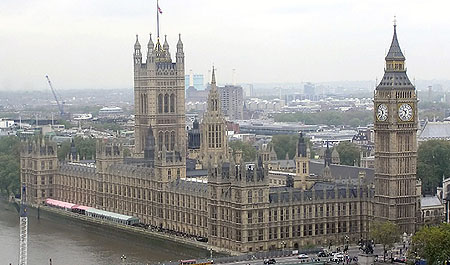HIS 102
Unit 2: Seventeenth-Century Europe

Westminster
Palace
in London. The Palace is where the two houses of the Parliament
of the United Kingdom (House of Lords and House of Commons) meet.
The building originally housed the English monarchs and dates to the
Middle Ages, but it has been rebuilt and expanded many times over the
centuries. One of the Palace's most famous features is the clock
tower to the right (where the famous bell Big Ben is located).
The other main tower is the Victoria tower. It was Parliament
which carried out the "Glorious Revolution" in 1688, removing King
James II from the throne of England. Photo courtesy Wikipedia Commons.
 What you must do in this unit
What you must do in this unit
- Read chapters 14 and 15 in the textbook. Students often have asked me about the purpose of the textbook in the course. Let me offer two points. 1st, we can't cover everything in world history, and so the textbook helps provide the linking material between the topics that we cover in each unit. The textbook also offers information about each of the topics that we do cover in the course. 2nd, the textbook is a good starting point to help you answer the key terms and questions to consider for each unit of the course. And finally, 3rd, the textbook is a big help in studying for the timeline on the final exam, and also for the maps on both exams.
- Read my notes on Seventeenth-Century Europe and Louis XIV and watch the short video on the Seventeenth Century by Professor Evans. You can also check out Professor Campbell's video, Was The Atlantic Slave Trade B.S.?
- Study the Questions to Consider and the Key Terms for the week.
- Submit the Required Seventeenth-Century paragraph (50 points).
What you should do in this unit
What you can do in this unit
- Listen to some further information about this unit
as a mp3 file. You can also read the information as
a txt file.
- Please read the Sample Historical
Document Analysis,
based on some excerpts from Hammurabi's code of law. The sample illustrates some of the questions
that a historian asks when reading a historical document. This is what you will be doing in this course.
- The website on The Glorious Revolution is a good overview.
- Often within the course, you will find an extra credit option to answer study questions on the unit's reading (see below for the link to the Bill of Rights study questions). Your answers to study questions should not be simple yes/no answers, but they should be thorough answers. Here is a link to an example of outstanding study question answers done by one of the students in HIS 112. Please notice the completeness of each answer.
Some videos that you can watch for this unit
Extra Credit Options
- For up to 25 points of extra credit, write a one-page paper, What was
Louis XIV's conception of absolutism? Please be sure to cite your
sources.
- For up to 25 points of extra credit, compare and contrast the reigns of
Louis XIV and Peter the Great in a one-page paper. Please be sure to cite your
sources.
- For up to 10 points of extra credit, read the English Bill of Rights and write a paragraph in which you examine, Was the English Bill of Rights a
democratic document? Note the earlier important political
document in England was the Petition of Right (1628).
- For up to 10 points of extra credit, read the short excerpt (*.pdf file) from Utopia (1516) by Sir Thomas More (1478-1535) and comment in a long paragraph about its relevance over the succeeding centuries.
- For up to 5 points of extra credit, answer the English Bill of Rights study sheet questions.
- For extra credit, please suggest a
relevant website for this unit of the course. Send your instructor the title of the site, the URL and a brief explanation why you find the information interesting and applicable to the material being studied this unit.
Unit Learning Objectives
- Upon successful completion of this unit, you will be able to (1) demonstrate knowledge of the European state system of the seventeenth century and (2) describe the foundation and growth of French absolutism and English constitutionalism.
|